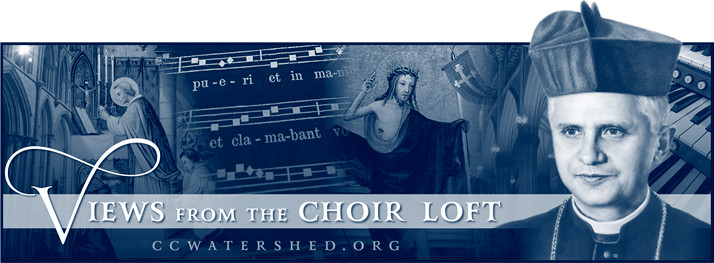The following is a guest article by Royce Nickel.

 HEN I BECAME music director at my last parish, I was distressed by some of the liturgical music I found in use. The Responsorial Psalm settings provided jazz chords to accompany the cantor’s verses, and the Gospel Acclamation was a jaunty little 6/8 melody that bore the name “Celtic Alleluia,” though in what way it was “Celtic” I never discovered.
HEN I BECAME music director at my last parish, I was distressed by some of the liturgical music I found in use. The Responsorial Psalm settings provided jazz chords to accompany the cantor’s verses, and the Gospel Acclamation was a jaunty little 6/8 melody that bore the name “Celtic Alleluia,” though in what way it was “Celtic” I never discovered.
Out of my distress was born the project of composing Responsorial Psalms in a rather different style. These ended up being posted at CCW’s Chabanel website, and some time later Jeffrey Ostrowski invited me to begin composing settings of the Gospel Acclamation for the Garnier Alleluias site as well.

 Y GOAL WITH THE RESPONSORIAL PSALMS was to provide a melodic setting of the psalm refrain simple enough that it could be used by a congregation of quite modest musical ability. But at the same time, it had to sound sacred. It had to use the melodic language and idiom of the Church’s own tradition of sacred liturgical music, and it had to do this, though very simply, as beautifully as possible. This meant, first, that the rhythm of the Psalm refrain’s melody was not metrical but, as in Gregorian chant, non-metrical, articulating and elaborating on the speech rhythm of the text being sung. Second, the melody itself, and the organ accompaniment, would use the Church’s modes, exemplifying in typical ways the contours and habits of modal melody in each of the modes.
Y GOAL WITH THE RESPONSORIAL PSALMS was to provide a melodic setting of the psalm refrain simple enough that it could be used by a congregation of quite modest musical ability. But at the same time, it had to sound sacred. It had to use the melodic language and idiom of the Church’s own tradition of sacred liturgical music, and it had to do this, though very simply, as beautifully as possible. This meant, first, that the rhythm of the Psalm refrain’s melody was not metrical but, as in Gregorian chant, non-metrical, articulating and elaborating on the speech rhythm of the text being sung. Second, the melody itself, and the organ accompaniment, would use the Church’s modes, exemplifying in typical ways the contours and habits of modal melody in each of the modes.
For the Psalm verses to be sung by the cantor I chose to employ the Gregorian psalm tones. It is true that the use of the ancient psalm tones for texts in English has been a matter of recent debate, some asserting that it is not possible to fit the cadences of the Gregorian tones, originally for singing Latin texts, to the somewhat different stress and accent patterns of the English. To me the arguments against using the ancient tones in English have always seemed overstated and not sufficiently grave to justify depriving ourselves of their sacred beauty. Indeed, it seems remarkable to me that Catholic musicians should debate the possibility of a form of psalmody that has in fact been practiced day in and day out for the last four centuries by the Anglicans.

 OR THE ENTIRE CYCLE of Gospel Acclamations I am providing seven different Alleluia melodies, each set in a different mode. These are distributed over the Church year to mark the seasons, for example, a Mode II Alleluia for the Advent season, a Mode VII Alleluia for Christmas and Epiphany, Mode III for Lent, and so on. Keeping the same Alleluia melody for the whole season allows the congregation to become familiar with it and, as the seasons change, serves to mark the times of the Church year.
OR THE ENTIRE CYCLE of Gospel Acclamations I am providing seven different Alleluia melodies, each set in a different mode. These are distributed over the Church year to mark the seasons, for example, a Mode II Alleluia for the Advent season, a Mode VII Alleluia for Christmas and Epiphany, Mode III for Lent, and so on. Keeping the same Alleluia melody for the whole season allows the congregation to become familiar with it and, as the seasons change, serves to mark the times of the Church year.
Whereas with the Responsorial Psalm settings I used the simpler formula of the Gregorian psalm tones that comes from the Daily Office, for the verses of the Gospel Acclamations I chose the more elaborate formula of the mass psalm tones. This decision was motivated by the reflection that, as the reading of the Holy Gospel is the high point of the entire Liturgy of the Word, a greater solemnity of style is appropriate.
Also, the beauty and glory of the mass psalm tones needs to be heard again as a vehicle for sacred text. It is true that the mass tones are traditionally used for the verses attached to the Introit and Communion chants of the Roman Gradual. Many parishes, however, simply do not yet have the musical resources to make use of those chants. Using the mass tones instead for the verse at the Gospel Acclamation is an adaptation rather than a novelty, in that it provides a way to highlight an important moment in the mass using the traditional musical language of the Church.
As a sample, here are this coming Sunday’s settings of the Responsorial Psalm and the Gospel Acclamation:
* * Responsorial Psalm for this Sunday
* * Gospel Acclamation for this Sunday

